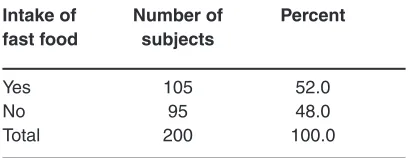A Study on the Frequency of Food Consumption and Its Relationship to BMI in School Children and Adolescents in Abha City, KSA.
Full text
Figure




Related documents
The positive nuclear expression of non-phospho β -catenin showed a significant correlation with positive CTNNB1 mutation status detected by Sanger method ( p = 0.025), and poor
An important element of the solving algorithm is aimed on the continuous tracking of the position of the pendulum in order to detect the collision with the unilateral
menghubungkan jaringan pusat dengan jaringan cabang pada PT. Mitra Dana Putra Utama Finance. VPN menjadi solusi permasalahan yang ada pada PT. Mitra Dana Putra Utama
The variables that we are using to predict a college student’s success are their high school grade point average, high school course grades, and high school coursework.. While
Representatives from top busi- ness schools around the world came together to discuss the future of man- agement education and the synergies between business schools and
The text adventure game uses the “>” in the same way that the DOS operating system does, indicating that the player is supposed to enter a , as well as other text adventure
A lightweight Table Driven Source Routing (TDSR) protocol can maintain more network topology information than Distance Vector (DV).. To facilitate source routing and also
Compared with the previous transthoracic echocardiographic examination, there was enlarged pericardial effusion, 3 cm behind the left ventricular posterior (Figure 4) wall